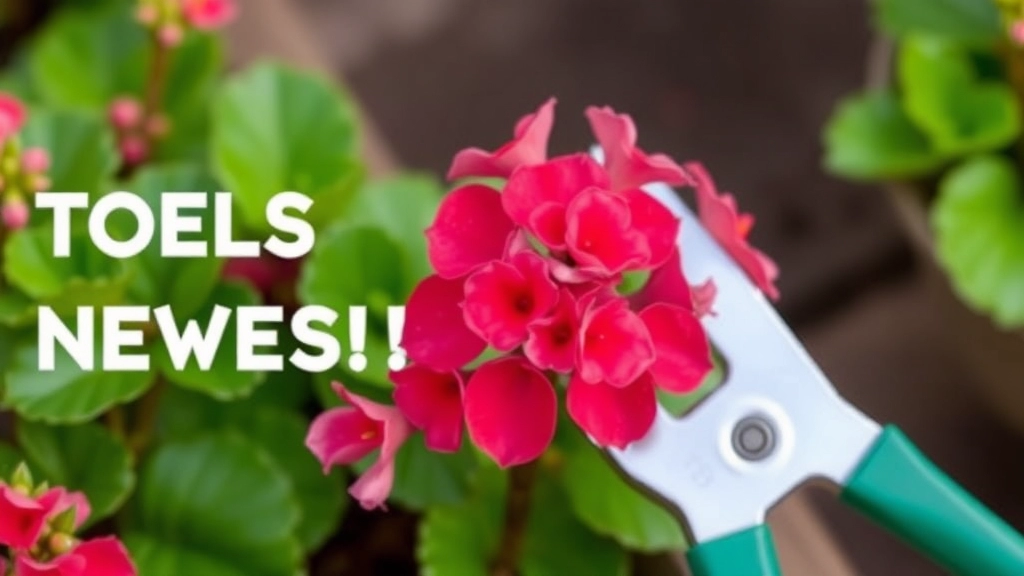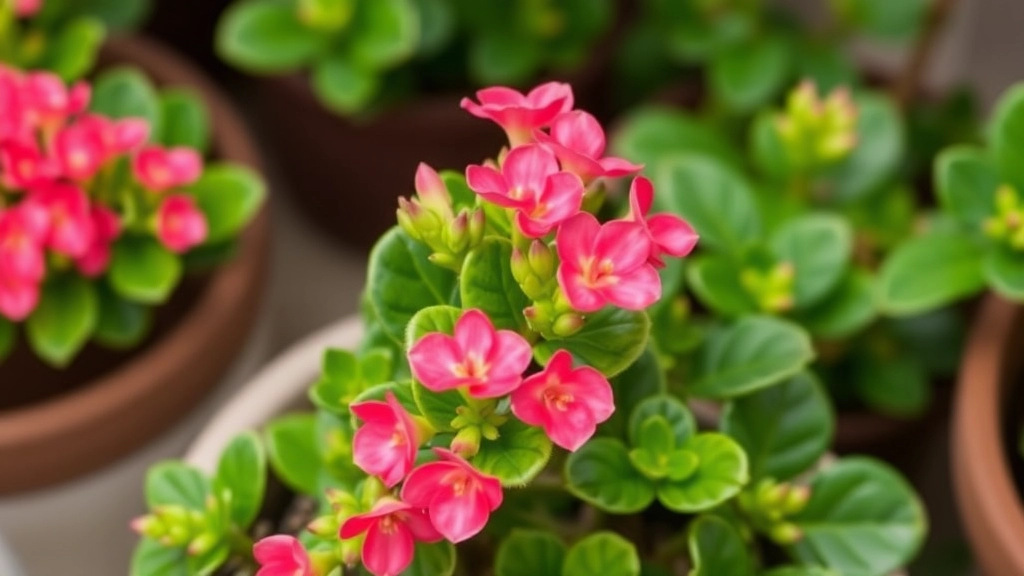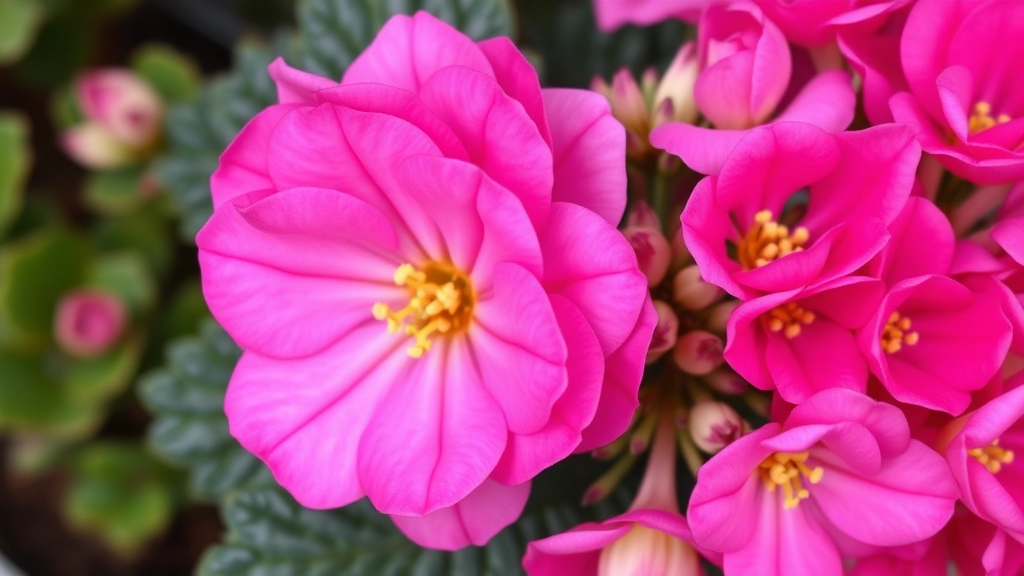Pruning Kalanchoes: A Florist’s Guide
As a passionate florist and Kalanchoe enthusiast, I’m thrilled to share my insights on pruning these beautiful plants. Proper pruning is crucial for maintaining healthy, vibrant Kalanchoes, and in this article, we’ll explore the best techniques, tools, and timing for this essential task. From post-bloom care to seasonal strategies, I’ll guide you through every step of the pruning process.
Whether you’re a seasoned plant parent or new to the world of Kalanchoes, you’ll find valuable tips to keep your plants thriving. We’ll cover common mistakes to avoid, how to handle pruned cuttings, and the numerous benefits of regular pruning. By the end of this guide, you’ll be equipped with the knowledge to confidently prune your florist Kalanchoe and enjoy its lush growth and stunning blooms year-round.
When to Prune Kalanchoe Plants
Hey there, fellow plant lovers! Let’s chat about when to give your Kalanchoe a little haircut. Trust me, timing is everything when it comes to pruning these beauties.
The Golden Rule: Post-Bloom Pruning
Here’s the deal: the best time to prune your Kalanchoe is right after it’s finished flowering. Why? Well, it’s like giving your plant a fresh start. Once those blooms have faded, your Kalanchoe is ready for a makeover.
Seasonal Sweet Spots:
- Spring: Perfect for a post-winter tidy-up
- Late Summer: Prep for fall growth
- Early Fall: Shape up before the dormant season
But wait, there’s more! Keep an eye out for these signs:
- Leggy growth: If your Kalanchoe’s looking a bit stretched out, it’s time for a trim.
- Yellowing leaves: Snip ’em off to keep your plant healthy.
- Overcrowding: Too many stems? Time to thin things out.
Pro Tip: Avoid pruning during active blooming. It’s like interrupting someone mid-sentence – not cool!
Remember, Kalanchoes are tough cookies. They can handle a good pruning, so don’t be shy. Just make sure you’ve got the right tools (more on that later) and you’re good to go.
Quick Question: Have you ever pruned your Kalanchoe at the wrong time? What happened? Drop a comment and let’s learn from each other!
Next up, we’ll dive into the tools you’ll need to make pruning a breeze. Stay tuned!
Tools Needed for Pruning Kalanchoe

When it comes to pruning Kalanchoe, you don’t need a fancy toolbox.
But having the right gear can make the job a breeze.
Here’s what I use:
- Sharp scissors or pruning shears
These are your go-to for most cuts. Keep ’em clean and sharp! - Small, precise scissors
For those tricky, delicate spots. Think eyebrow scissors, but for plants. - Rubbing alcohol
To clean your tools between cuts. Keeps nasties at bay. - Gloves
Optional, but nice if you’re dealing with lots of plants. - A clean cloth
For wiping down tools and your work area.
Pro tip: Always sanitise your tools before and after pruning.
It’s like washing your hands before cooking – just good practice.
Remember, you don’t need to break the bank.
Most of these items are probably already in your home.
The key is to keep everything clean and sharp.
Your Kalanchoe blossfeldiana hybrid will thank you for it.
Next time you’re pruning, think of it as giving your plant a spa day.
With the right tools, you’ll be a Kalanchoe tomentosa propagation pro in no time.
Step-by-Step Guide to Pruning Kalanchoe
Alright, let’s dive into the nitty-gritty of pruning your Kalanchoe. Trust me, it’s not rocket science, but there are a few tricks to get it right. Here’s how I do it:
1. Timing is everything
First things first, make sure you’re pruning at the right time. Usually, this is after the flowering season. You’ll know it’s time when those blooms start looking a bit sad.
2. Grab your tools
Get your clean, sharp pruning shears ready. Emphasis on clean – we don’t want to spread any nasties to our plant babies.
3. Start with the dead stuff
Begin by snipping off any dead, damaged, or diseased parts. It’s like giving your Kalanchoe a fresh haircut – out with the old, in with the new!
4. Shape it up
Now, let’s talk about shaping. I like to cut back the longest stems by about a third. This encourages bushier growth and stops your Kalanchoe from getting too leggy.
5. Don’t forget the flowers
If there are any spent flowers left, snip those off too. It’s like telling your plant, “Hey, time to focus on growing new stuff!”
6. Make clean cuts
When you’re cutting, aim for just above a leaf node. That’s where new growth will sprout from. And always cut at a slight angle – it helps water run off and prevents rot.
7. Step back and assess
After a bit of pruning, take a step back and look at your handiwork. Is it balanced? Does it look good from all angles? Don’t be afraid to make a few more snips if needed.
8. Clean up
Once you’re done, clean up any fallen leaves or stems. These can attract pests if left lying around.
Remember, pruning Kalanchoe isn’t about being perfect. It’s about encouraging healthy growth and keeping your plant looking its best. The more you do it, the more confident you’ll become. And who knows? You might even start enjoying it as much as I do!
How to Handle Pruned Kalanchoe Cuttings
Ever wondered what to do with those Kalanchoe bits you’ve just snipped off? Let’s chat about that.
Handling Kalanchoe cuttings isn’t rocket science, but there’s a knack to it.
First things first: don’t chuck ’em in the bin!
These cuttings are like gold for plant lovers. Here’s why:
- Propagation potential
- Compost material
- Natural pest control
Let’s break it down, shall we?
Propagation: The Green Thumb’s Jackpot
Got a cutting that’s at least 3 inches long? Jackpot!
Here’s what you do:
- Strip off the lower leaves
- Let it dry for a day or two (callusing, they call it)
- Stick it in some well-draining soil
- Water sparingly
Boom! You’ve got yourself a baby Kalanchoe in the making.
Compost: Turning Trash into Treasure
Not keen on more plants? No worries.
Toss those cuttings in your compost bin. They’ll break down and feed your other green babies.
Natural Pest Control: The Sneaky Trick
Did you know Kalanchoe can keep pests at bay?
Scatter some cuttings around your other plants. It’s like a natural bug repellent.
Common Mistakes to Avoid
- Don’t let cuttings sit in water too long – they’ll rot
- Avoid direct sunlight for fresh cuttings – they’re sensitive
- Don’t overwater new propagations – Kalanchoe likes it dry
Remember, handling Kalanchoe cuttings isn’t just about waste management. It’s about maximising your plant’s potential.
So next time you’re pruning your florist Kalanchoe, think twice before binning those bits. They might just be the start of your next green adventure!
Common Mistakes to Avoid During Kalanchoe Pruning
Let’s chat about pruning Kalanchoe plants. I’ve seen folks make some real blunders here, and I want to help you dodge those bullets. Trust me, I’ve been there, done that, and learned the hard way.
First off, don’t go hacking away like you’re in a slasher film. Kalanchoes aren’t villains; they’re your green buddies. Here are some no-nos to keep in mind:
1. Timing Troubles
- Pruning when the plant’s flowering (big mistake!)
- Cutting back during dormant periods (not cool, mate)
2. Tool Terrors
- Using dirty or blunt tools (hello, plant diseases!)
- Opting for massive shears when precision snips would do
3. Overzealous Cutting
- Chopping off more than a third of the plant (easy there, Edward Scissorhands)
- Removing all the leaves (plants need those, you know)
4. Ignoring the Plant’s Signals
- Pruning healthy stems just ’cause (if it ain’t broke, don’t fix it)
- Leaving dead or diseased parts (that’s like keeping rotten apples with the good ones)
5. Post-Pruning Neglect
- Forgetting to water after pruning (plants get thirsty too)
- Exposing freshly pruned plants to direct sunlight (sunburn is real for plants)
Here’s the deal: Kalanchoe pruning isn’t rocket science, but it’s not a walk in the park either. You’ve got to find that sweet spot between giving your plant a haircut and going full-on buzz cut.
Remember, each snip is like a conversation with your plant. You’re telling it where to grow, how to shape up, and basically giving it a roadmap for the future. So, be gentle, be thoughtful, and most importantly, be patient.
Avoid these common mistakes, and you’ll be well on your way to having a Kalanchoe that’s the envy of the neighbourhood. Trust me, once you get the hang of it, pruning becomes less of a chore and more of a zen moment with your green pals.
So, next time you’re about to prune your Kalanchoe, take a deep breath, think about these tips, and go forth with confidence. Your plants will thank you, and you’ll feel like a proper green-thumbed guru.
Post-Pruning Care for Kalanchoe Plants

Just pruned your kalanchoe? Awesome! Let’s chat about what’s next.
Proper post-pruning care is crucial for your kalanchoe’s health and growth.
Here’s what I do after I’ve given my kalanchoe a trim:
1. Watering:
- Hold off on watering for a day or two
- When you do water, give it a good soak
- Let the soil dry out between waterings
2. Light:
- Place your kalanchoe in bright, indirect sunlight
- Avoid harsh afternoon rays – they can scorch the leaves
3. Feeding:
- Wait about two weeks before fertilising
- Use a balanced, water-soluble fertiliser
- Dilute it to half strength – kalanchoes aren’t big eaters
4. Monitoring:
- Keep an eye out for new growth
- Watch for any signs of stress or disease
5. Temperature:
- Keep your kalanchoe in a warm spot
- Aim for temperatures between 15-21°C (59-70°F)
Pro tip: If you’ve pruned heavily, your kalanchoe tomentosa might need some extra TLC.
Don’t freak out if it looks a bit sad at first. That’s normal.
Give it time, and you’ll see new growth in no time.
Remember, post-pruning care is all about creating the right conditions for recovery and growth.
Treat your florist kalanchoe plant right, and it’ll reward you with lush foliage and stunning blooms.
Seasonal Pruning Tips for Kalanchoe
Alright, let’s chat about pruning your Kalanchoe throughout the year. Trust me, it’s not rocket science, but getting it right can make a world of difference.
Spring: The Comeback Kid
As the days get longer and warmer, your Kalanchoe’s ready to party. Here’s what you need to do:
- Trim off any winter-damaged bits
- Shape it up for new growth
- Don’t go overboard – a light trim does the trick
Summer: Maintenance Mode
It’s all about keeping your plant looking fresh during the growing season:
- Pinch off spent blooms regularly
- Trim leggy stems to encourage bushiness
- Keep an eye out for any diseased parts and snip ’em off
Autumn: Prep for Dormancy
As things cool down, your Kalanchoe’s getting ready for a bit of a snooze:
- Cut back on watering
- Remove any remaining flower stalks
- Trim it back by about a third to keep it compact
Winter: Hands Off (Mostly)
Your Kalanchoe’s having a kip, so let it be:
- Only prune if you spot dead or diseased bits
- Hold off on major pruning until spring
Pro Tip: Always use clean, sharp tools when pruning your Kalanchoe. You wouldn’t want a rusty pair of scissors for your haircut, would you?
Remember, pruning Kalanchoe isn’t about following a strict rulebook. It’s about understanding your plant and giving it what it needs. Keep an eye on it, and you’ll soon get a feel for when it needs a trim.
So there you have it – your year-round guide to keeping your Kalanchoe in tip-top shape. Stick to these seasonal pruning tips for Kalanchoe, and you’ll have a plant that’s the envy of the neighbourhood.
Benefits of Regular Pruning for Kalanchoe
Let’s chat about why pruning your Kalanchoe is a game-changer.
Ever wondered why some plants look bushy and full while others seem lanky?
Regular pruning is the secret sauce.
Here’s why you should make it a habit:
1. Shape control:
- Keeps your Kalanchoe looking neat and tidy
- Prevents it from getting too leggy or sprawling
2. Healthier growth:
- Encourages new shoots and leaves
- Helps the plant focus energy on strong, healthy parts
3. More blooms:
- Pruning after flowering can lead to more frequent blooming
- You’ll get a fuller, more impressive display
4. Disease prevention:
- Removes dead or diseased parts before issues spread
- Improves air circulation, reducing fungal problems
5. Rejuvenation:
- Gives older plants a new lease on life
- Can help restore a neglected Kalanchoe
6. Size management:
- Perfect for keeping indoor Kalanchoes compact
- Ideal if you’re short on space
7. Propagation opportunities:
- Use pruned cuttings to grow new plants
- Share with friends or expand your collection
Remember, a well-pruned Kalanchoe is a happy Kalanchoe.
It’s not just about looks – it’s about plant health and longevity.
So grab those pruning shears and give your Kalanchoe some TLC.
Your plant will thank you with lush growth and stunning blooms.
FAQs on Florist Kalanchoe Pruning
1. How often should I prune my florist Kalanchoe?
Prune your Kalanchoe once or twice a year, typically after flowering. However, you can remove dead or yellowing leaves anytime.
2. Can I prune my Kalanchoe while it’s blooming?
It’s best to avoid pruning during active blooming. Wait until the flowers have faded to avoid disrupting the plant’s flowering cycle.
3. What tools do I need for pruning Kalanchoe?
Clean, sharp scissors or pruning shears are sufficient. Ensure they’re sterilized to prevent the spread of diseases.
4. How much should I cut back when pruning?
As a general rule, don’t remove more than one-third of the plant at a time. This ensures you don’t stress the plant too much.
5. Can I propagate from Kalanchoe prunings?
Yes! Stem cuttings from pruning can be used for propagation. Allow the cut end to callus before planting in well-draining soil.
6. Will pruning affect my Kalanchoe’s flowering?
Proper pruning can actually encourage more blooms. It stimulates new growth and can lead to a bushier plant with more flowering points.
7. How do I care for my Kalanchoe after pruning?
After pruning, place your Kalanchoe in bright, indirect light. Wait a day or two before watering, and hold off on fertilizing for about two weeks.
8. Is there a wrong way to prune Kalanchoe?
Avoid cutting into woody stems or removing all the leaves. Always make clean cuts just above a leaf node to promote healthy regrowth.

